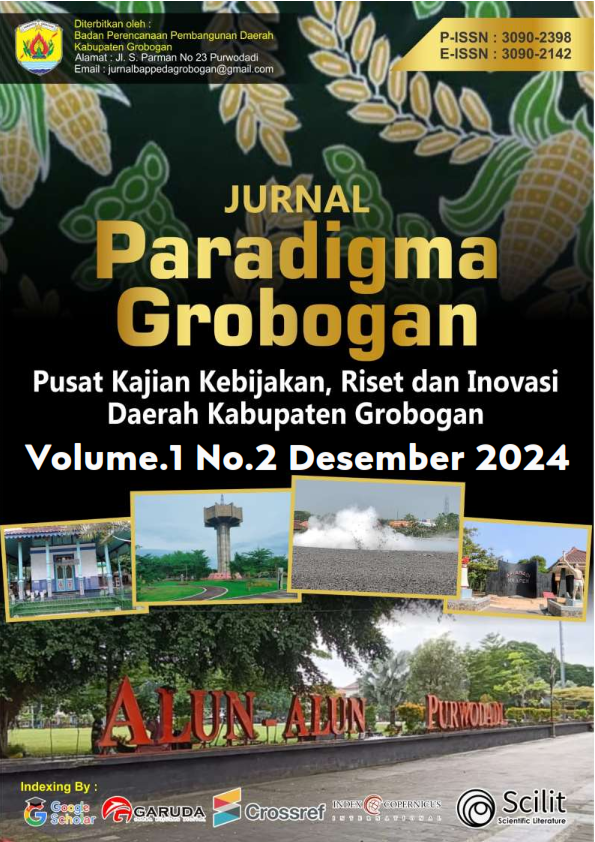Investigasi Air Tanah dengan Metode Geoscanner di Kabupaten Grobogan, Jawa Tengah
DOI:
https://doi.org/10.58684/paradigma.v2i1.49Keywords:
Geoscanner, resistivity, groundwater, aquifer, GroboganAbstract
Grobogan Regency is an agricultural region that frequently faces chronic drought, particularly during extended dry seasons. This situation significantly affects the agricultural sector and the availability of clean water for the population. This study aims to identify the subsurface geological conditions, lithological characteristics of the bedrock, and the distribution and potential of groundwater aquifers using a resistivity-based geoscanner method. This geophysical approach was chosen for its ability to map subsurface structures non-invasively. The research was conducted at six measurement points in Grobogan from July to September 2020. The resistivity data were analyzed using Res2Dinv software to generate two-dimensional subsurface profiles. The results revealed that rock resistivity values ranged from 0.06 to 821 ohm-meters, indicating lithological variations such as clay, sand, calcareous sandstone, marl, and hard limestone. Five distinct aquifer zones were identified with varying depths and thicknesses. One promising site indicated a productive groundwater zone at a depth of 30–70 meters, with a thickness exceeding 20 meters. These findings are expected to serve as a scientific foundation for planning groundwater exploration and sustainable water resource management in Grobogan, particularly in drought-prone areas. Furthermore, the use of geoscanner-based techniques presents a promising application of geophysical methods in the broader context of water resource planning in regions with similar geological settings.References
Aisyah, N., & Nugroho, R. (2021). Pemetaan Potensi Airtanah Menggunakan Metode Geolistrik di Wilayah Semi-Arid. Jurnal Geoteknik Indonesia, 18(2), 103–110.
Direktorat Geologi. (1988). Peta Hidrogeologi Lembar Semarang, skala 1:250.000. Pusat Penelitian dan Pengembangan Geologi, Bandung.
Direktorat Geologi. (1992). Peta Geologi Lembar Ngawi 1508-4. Pusat Penelitian dan Pengembangan Geologi, Bandung.
Direktorat Geologi. (1992). Peta Geologi Lembar Salatiga 1408-6. Pusat Penelitian dan Pengembangan Geologi, Bandung.
Fetter, C. W. (1994). Applied Hydrogeology. Merrill Publishing Company, Ohio.
Gundogdu, K. S., & Guney, Y. (2012). Application of electrical resistivity imaging for groundwater exploration in volcanic terrain. Journal of Applied Geophysics, 81, 1–8.
Haryono, E., et al. (2021). Studi Karakteristik Airtanah Daerah Karst Gunungkidul Menggunakan Metode Geolistrik. Jurnal Geosain, 13(2), 101–112.
Hermawan, Y., & Prasetyo, A. (2019). Analisis Zonasi Potensi Air Tanah Menggunakan Metode Resistivitas. Jurnal Teknik Sipil dan Lingkungan, 5(3), 207–215.
Kodoatie, R. J. (2010). Pengantar Hidrogeologi. Penerbit Andi, Yogyakarta.
Kusnadi, D., & Suryani, T. (2020). Penerapan Teknologi Geoscanner dalam Identifikasi Sistem Akuifer. Jurnal Teknologi Mineral, 8(1), 89–97.
Loke, M. H., & Dahlin, T. (2002). A comparison of the Gauss-Newton and quasi-Newton methods in resistivity imaging inversion. Journal of Applied Geophysics, 49(1), 149–162.
Lubis, R. F., & Muchsin, I. (2022). Pemetaan Sumber Daya Air Bawah Permukaan Menggunakan Pendekatan Geofisika. Jurnal Hidrogeologi Nasional, 4(2), 122–131.
Nasruddin, M., Sutopo, A., & Diah, A. S. (2019). Aplikasi Metode Resistivitas untuk Pemetaan Airtanah di Daerah Perdesaan. Jurnal Geoteknologi, 16(1), 35–46.
Nurrahman, R., & Hartanto, D. (2018). Studi Geolistrik Resistivitas Dua Dimensi untuk Deteksi Airtanah Dangkal. Geoscience Journal, 6(2), 114–121.
Prabowo, H., & Susanto, E. (2021). Korelasi Nilai Resistivitas dengan Kedalaman Airtanah di Daerah Dataran Rendah. Jurnal Lingkungan Tropis, 19(3), 211–218.
Rahayu, E. S., & Irianto, H. (2013). Kajian Keragaan Pasar dan Daya Saing Komoditas Tembakau sebagai Dampak Perubahan Iklim di Kabupaten Grobogan. Jurnal Sosial Ekonomi Pertanian dan Agribisnis (SEPA), 9(2), 209–218.
Suryadi, A., Wirawan, R. A., & Lestari, M. (2021). Integrasi Data Geolistrik dan GIS untuk Zonasi Potensi Airtanah di Wilayah Kekeringan. Jurnal Lingkungan dan Bencana Geologi, 12(3), 210–222.
Todd, D. K., & Mays, L. W. (2005). Groundwater Hydrology (3rd ed.). John Wiley & Sons.
Widodo, S., & Handoko, R. (2020). Evaluasi Potensi Air Tanah Menggunakan Interpretasi Data Geolistrik. Jurnal Sumberdaya Alam, 14(1), 33–41.
Zhou, H., Li, Y., & Chen, X. (2020). Identification of Aquifer Zones Using Electrical Resistivity Tomography. Hydrogeology Journal, 28(4), 1234–1247.





